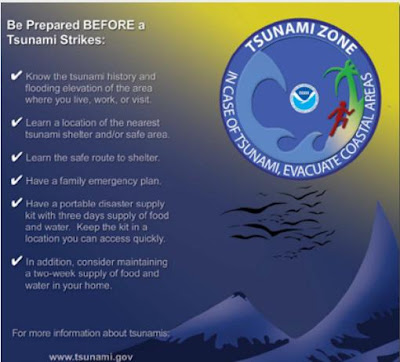# 11,190
The National Tsunami Hazard Mitigation Program (NTHMP) recognizes Tsunami Preparedness Week during the last week in March to coincide with the date of the 1964 Great Alaska Earthquake and Tsunamis. Some states and territories recognize other times of the year, and this year that includes:
- March 13-19: Puerto Rico, U.S. Virgin Islands
- March 20-March 26: California
- March 27-April 2: Alaska, Guam, Maine, New Hampshire
- April: Hawaii
- September 24-30: American Samoa
- October: Oregon, Washington
But regardless of when your region observes this week, if you live (or visit) anywhere near areas that could be affected by a tsunami, it is important to know what to do if one threatens.
Since they don’t happen very often, the threats from great earthquakes and volcanic eruptions - and the tsunamis they can produce - are often under appreciated, particularly in North America and Europe.
While we think of these disasters as primarily localized events, impacting a few thousand square miles, our oceans can transfer the released energy from an earthquake, meteor strike, volcanic eruption, or undersea landslide across distances of thousands of miles in the form of a tsunami (or more likely, a series of tsunami waves).
Which is precisely what happened in The Great Lisbon earthquake of 1755, which sent tsunami waves crashing into Spain, Portugal, England, North Africa, and was felt as far away as the Caribbean.
Wave heights were reportedly as high as 20 meters (66 ft.) in North Africa, while a 3-meter tsunami struck at Cornwall on the Southern English coast and in Galway, Ireland waves damaged the `Spanish Arch’ section of the city wall.
 |
| Lisbon Tsunami - Credit Wikipedia |
The west coast of North America, since they are vulnerable to tsunamis generated by seismic events in Japan, Alaska, the South Pacific, and even the long expected `big one' off the Pacific Northwest's coast (see Just A Matter Of Time), is viewed as the most `at risk'.
But last year, in The Caribbean’s Hidden Tsunami Potential (Revisited), we looked at that region’s history – and potential – for generating tsunamis that could affect the Gulf Coast and Atlantic coastlines of the United States, along with Mexico, Central America, and South America.
You can access current Tsunami warnings and arrival times at the Pacific Tsunami Warning Center.
While you may think it unlikely that a tsunami will affect you or your region - this is just one of many potential hazards that may threaten you and your community - and they all require similar preparedness steps.
Knowing your local threats, whether they be tsunamis, forest fires, floods, earthquakes or hurricanes . . . and then becoming prepared to deal with them, will provide you and your family the best safety insurance available.
As far as what to do before a tsunami threatens, READY.GOV has a Tsunami Awareness Page with helpful hints. NOAA provides several useful documents, including a Tsunami Zone PDF (see below) and Tsunami Web page.
Everyone - regardless of where they live - needs an appropriate disaster plan, just as everyone should have a good first aid kit, a `bug-out bag’, and sufficient emergency supplies to last a bare minimum of 72 hours.
As the graphic above from NOAA advises, people should consider maintaining a 2-week supply of supplies in their home. A topic I address in When 72 Hours Isn’t Enough.
As we move into the spring severe storm season, and ultimately back into the Atlantic Hurricane season, now is a good time to review and refresh your emergency preparedness plans.
It doesn't take a huge investment in either time or money for you and your family to become better prepared. It just takes the resolve to do so. But I can assure you, just having the peace of mind knowing you are prepared for an emergency is well worth the effort.
After all, preparing is easy . . . it’s worrying that is hard.


